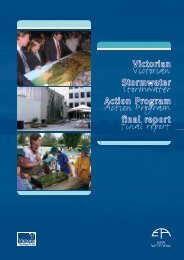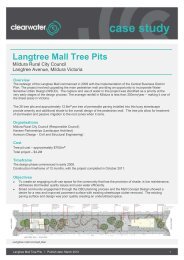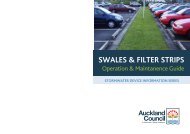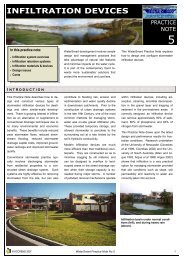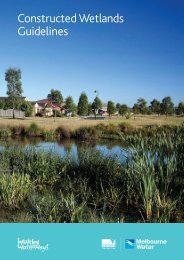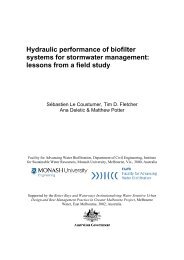CRC Street Sweep Eval 1999.pdf( 489.9 KB ) - Clearwater
CRC Street Sweep Eval 1999.pdf( 489.9 KB ) - Clearwater
CRC Street Sweep Eval 1999.pdf( 489.9 KB ) - Clearwater
Create successful ePaper yourself
Turn your PDF publications into a flip-book with our unique Google optimized e-Paper software.
COOPERATIVE RESEARCH CENTRE FOR CATCHMENT HYDROLOGY<br />
Executive Summary<br />
<strong>Street</strong> cleansing is a common (and expensive)<br />
practice undertaken by most urban municipalities<br />
with annual expenditure by a municipality often<br />
exceeding one million dollars. <strong>Street</strong> sweeping,<br />
essentially the operation of large trucks for cleaning<br />
street surfaces, is primarily performed for aesthetic<br />
purposes. It is, often perceived to lead to<br />
improvements in the environmental conditions of<br />
urban waterways by preventing pollutants deposited<br />
on street surfaces from reaching the stormwater<br />
system. There is, however, little available evidence to<br />
quantify the extent to which street sweeping can<br />
improve stormwater quality. This report investigates<br />
the effectiveness of street sweeping for stormwater<br />
quality improvement.<br />
The effectiveness of street sweeping for stormwater<br />
pollution control is examined for two types of<br />
pollutants, gross pollutants (> 5 mm) and sediment<br />
(including associated pollutants). The research<br />
literature on street cleaning indicates a general dearth<br />
of studies that address the issues of gross pollutant<br />
management. Most studies predominantly examine<br />
the effectiveness of street sweeping for sediment and<br />
associated contaminant removal. This study looks at<br />
the effectiveness of street sweeping for gross<br />
pollutants using the results of Australian field studies,<br />
while sediment and other suspended solid removal is<br />
investigated with interpretation of results from<br />
overseas studies.<br />
Experimental studies overseas found street sweeping<br />
to be highly effective in the removal of large solids<br />
greater than 2 millimetres under test conditions.<br />
However, field conditions are expected to<br />
significantly reduce the efficiency of solid removal<br />
because of limitations with sweeper access to source<br />
areas (mainly due to street design and car parking),<br />
sweeping mechanisms used and operator skills. Field<br />
studies undertaken by the Cooperative Research<br />
Centre for Catchment Hydrology (<strong>CRC</strong>CH) in<br />
Australia found significant stormwater gross pollutant<br />
loads generated from source areas in spite of a daily<br />
street sweeping regime.<br />
An earlier <strong>CRC</strong>CH study, involving analysis of gross<br />
pollutant loads from a 50 hectare urban catchment of<br />
mixed residential, commercial and industrial landuse,<br />
found a clear relationship between the gross<br />
pollutant load in the stormwater system and the<br />
magnitude of the storm event. The shapes of the<br />
curves relating gross pollutant load to event rainfall<br />
and runoff were found to be monotonically increasing<br />
and representable by a logarithmic function. The<br />
shape of these curves suggests that the limiting<br />
mechanism affecting the amount of gross pollutants<br />
entering the stormwater system is rainfall dependent<br />
(ie. the available energy to re-mobilise and transport<br />
deposited gross pollutants on street surfaces) rather<br />
than being source limiting (ie. the amount of available<br />
gross pollutants deposited on street surfaces).<br />
Overseas studies indicate that street sweeping is<br />
relatively ineffective at reducing the street surface<br />
load of fine particles (below 125 µm). The particle<br />
size distribution of suspended solids conveyed in<br />
stormwater in Australian conditions typically range<br />
from 1 µm to 400 µm with approximately 70% of the<br />
particles smaller than 125 µm. Therefore, street<br />
sweeping as it is currently practiced cannot be<br />
expected to be effective in the reduction of suspended<br />
solids and associated trace metals and nutrient<br />
concentrations in stormwater.<br />
The study concludes that the performance of street<br />
sweeping for stormwater pollutant control is limited<br />
and must be accompanied by structural pollutant<br />
treatment measures to effectively reduce the<br />
discharge of gross and sediment associated pollutants<br />
in stormwater. The incremental benefits in increasing<br />
the frequency of street sweeping beyond what is<br />
required to meet street aesthetic criterion is expected<br />
to be small in relation to water quality improvements.<br />
As a result, there seems little benefit in conducting an<br />
in-depth field-based study into the effectiveness of<br />
street sweeping for stormwater pollution control.<br />
ii




